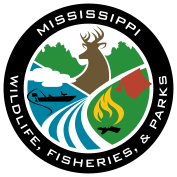
If you have questions about purchasing a license call 1-800-5GO-HUNT.
This page provides a guide to help Mississippi sportsmen and landowners simply and economically establish supplemental plantings and forage mixtures for wildlife, as well as evaluate food plots using exclosure cages.
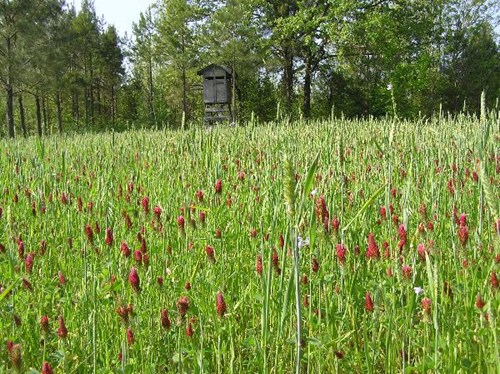 Planting supplemental forages is a popular method of attracting deer. However, one must remember that food plots should not be used as a "quick-fix" nor substituted for proper habitat management practices. Food plots can be used to supplement essential nutrients that may be lacking in native forage. They are also valuable as a tool to facilitate harvest and to increase non-hunting viewing opportunities. Regardless of the purpose, consideration must be given to each of the following to ensure successful establishment:
Planting supplemental forages is a popular method of attracting deer. However, one must remember that food plots should not be used as a "quick-fix" nor substituted for proper habitat management practices. Food plots can be used to supplement essential nutrients that may be lacking in native forage. They are also valuable as a tool to facilitate harvest and to increase non-hunting viewing opportunities. Regardless of the purpose, consideration must be given to each of the following to ensure successful establishment:
When choosing a site to use as a food plot, the primary consideration should be soil productivity. Productive soils are those that have adequate fertility, moisture, drainage, and texture. However, other factors such as adequate sunlight, accessibility, size, shape, and arrangement must also be considered.
A good rule of thumb is to make plots a minimum of one acre in size, irregularly shaped, and at least 1 mile apart. We recommend that 3-5% of an ownership be devoted to supplemental plantings that include a diversity of cool season, warm season, and permanent forages.
If land ownership prevents the establishment of food plots in ideal locations, acceptable alternatives may include existing openings such as logging decks, fallow fields, utility right-of-ways, fire lanes, and logging roads. However, the establishment of supplemental forages adjacent to public roads is not recommended because of the increased potential for deer-vehicle collisions and poaching.
Most sportsmen accept the necessity of proper fertilization for optimal forage growth of supplemental wildlife plantings, but rarely do they consider liming or soil pH. The two components, fertilization and pH, work together. Proper systemic uptake of fertilizer is diminished if soil pH is low. For example, if soil pH is around 4.5, close to 80% of the money you spend on fertilizer is wasted.
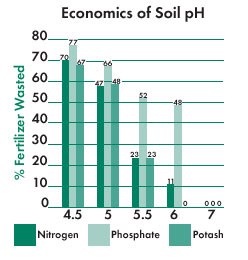 In addition, important soil nutrients such as zinc, manganese and iron are either unavailable or toxic to some plants if soil pH is not correct. Farmers have long since learned the importance of this relationship. If the wildlife manager of today desires to move up to efficiently utilizing soil and producing maximum amounts of quality forage at the most economical rates, he must learn from the successful farmer.
In addition, important soil nutrients such as zinc, manganese and iron are either unavailable or toxic to some plants if soil pH is not correct. Farmers have long since learned the importance of this relationship. If the wildlife manager of today desires to move up to efficiently utilizing soil and producing maximum amounts of quality forage at the most economical rates, he must learn from the successful farmer.
Begin supplemental wildlife plantings by soil sampling several months prior to planting time. The Mississippi Cooperative Extension Service is a valuable and competent source for soil sampling information, analysis, and interpretation. They can provide you with instructions and a soil sampling kit, and have samples analyzed at a cost of $3.00 each.
When you receive your soil analysis, you will be provided with specific recommendations for liming and fertilization. The time to complete pre-planning of your cool season plantings is late spring to early summer.
Soil pH is a measure of the acidity or alkalinity of the soil. This measure ranges from 1 to 14, with 7 considered neutral. Any value less than 7 is categorized as acidic, while values greater than 7 are alkaline. Normally, soils will not be more acidic than 3.5 or more basic than 10. Most soils in Mississippi that have not been previously limed will be moderately acidic (usually around 4.0 - 5.0) due to humid conditions and the decomposition of leaves, twigs, and other plant materials.
The goal of the wildlife manager should be to achieve a soil pH of 7.0. A value of 6.7 - 7.0 will net maximum productivity, especially on legumes and, to a lesser extent, on cereal grains such as wheat and oats. Proper inoculation of legumes is even more critical on acidic soils because the bacteria that aid legumes in fixing nitrogen are more limited on acidic soils.
Your soil analysis will be returned with site-specific recommendations on lime application rates. Do not be surprised if you receive a recommendation of 3 tons of lime per acre on some of your sites that have never been limed. (In the absence of soil testing, a rule of thumb for lime application is to add 2 tons per acre every third year.) You may also learn that some types of soils require more lime than others to achieve the same result. Clay soils will typically receive higher recommended lime application rates than some of the more sandy soils.
There are many liming materials available on the market. Each of these materials will have varying efficiency ratings. The only way to be sure of what you are getting is to deal with a reputable dealer. For simplicity, we will limit our discussion to powdered and pelletized forms. The powdered form is the most economical. The drawback to the powdered form is that a commercial spreader truck must be able to access the planting site. But, if access is not a problem, this will certainly be the recommended method of application. You will get the most benefit from the lime if it is applied and disked into the soil up to three months prior to planting time. Adequate soil moisture will also increase the ability of the lime to increase soil pH.
On small areas or on plantings that are inaccessible by the spreader truck, pelletized lime can be utilized. This form of lime is packaged in 50-pound bags. Accompanying this price is the added burden of uniformly applying the pelletized lime on the planting site. This application is normally made with a fertilizer/seeder spreader attached to a small farm tractor. Smaller electric versions of the seeder are now available as ATV attachments. The opportunities to utilize an ATV and assorted attached implements for disking, seeding, fertilizer/lime application, harrowing, herbicide application, and even culti-packing are creating situations where supplemental wildlife plantings can be incorporated in remote areas of a landowner's property.
Intelligent and economical fertilization of supplemental wildlife plantings will consist of applying a specific amount of three basic elements. These elements are expressed as nitrogen (N), phosphorus (P), and potassium (K). They are usually expressed in numerical form, such as the standbys 13-13-13 and 6-8-8. In these mixtures, the number is actually the percent of that particular element in the mixture. For example, in the 13-13-13 mixture, the first 13 is the percent of total nitrogen, the second 13 is the percent of available phosphorous, and the third 13 is the percent of available potassium. These nutrient values can be 0, so do not be surprised to see a recommendation of a mixture such as 0-46-46 on a soil analysis form.
Local feed stores do not carry every combination of fertilizer mixtures. However, larger dealers will custom blend almost any mixture you request. Allow them several days' notice to prepare your mixture. If custom blending is not possible, you can adjust pre-mixed combinations to fit most of your basic needs. For example, 5-10-10 supplies the same equivalent mixture as 10-20-20. But where you would apply one ton of 5-10-10/acre, you would only need to apply 1/2 ton of 10-20-20.
Plants are most palatable and subsequently most nutritious when they are actively growing. However, as a plant matures, fiber content increases, and protein levels decrease. By planting different forage species with staggered maturity dates within the same food plot, the length of time that highly digestible forage is available will be increased. Combination plantings will also reduce the risk of total crop failure due to insects, disease, or adverse weather, since different species grow and mature at different rates.
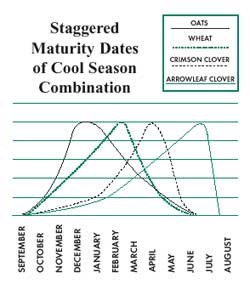 Planting cool season food plots with a mixture of cereal grains and clovers can provide deer with quality forage during times of nutritional stress. A cool season combination that does well in the south is a mixture of oats, wheat, crimson clover, and arrowleaf clover. Oats and wheat will germinate and grow quickly to ensure quality forage is available during the hunting season. Although the clover seed will germinate, growth will be slow until late winter, when crimson clover will begin rapid growth that continues until blooming in late March to mid-April. At that point, the arrowleaf clover will begin to actively grow. Arrowleaf (depending on the variety) will mature from mid-June until the first of July. Therefore, this mixture can supply quality forage on the same food plot from October through June.
Planting cool season food plots with a mixture of cereal grains and clovers can provide deer with quality forage during times of nutritional stress. A cool season combination that does well in the south is a mixture of oats, wheat, crimson clover, and arrowleaf clover. Oats and wheat will germinate and grow quickly to ensure quality forage is available during the hunting season. Although the clover seed will germinate, growth will be slow until late winter, when crimson clover will begin rapid growth that continues until blooming in late March to mid-April. At that point, the arrowleaf clover will begin to actively grow. Arrowleaf (depending on the variety) will mature from mid-June until the first of July. Therefore, this mixture can supply quality forage on the same food plot from October through June.
To establish this mixture, the following seeding rates are recommended:
Seedbed preparation should begin with thorough disking of the selected site in September. The plot should then be harrowed to achieve a uniform planting surface. The seed mixture should then be thoroughly blended (after legume inoculation) and evenly broadcast over the prepared surface.
After seed distribution, cover the broadcast seed by lightly harrowing. It is important to note that this mixture should not be planted any deeper than 1/2 inch for proper growth of the clover component. A culti-packer can be used at this point to help preserve existing soil moisture and to insure seed/soil contact.
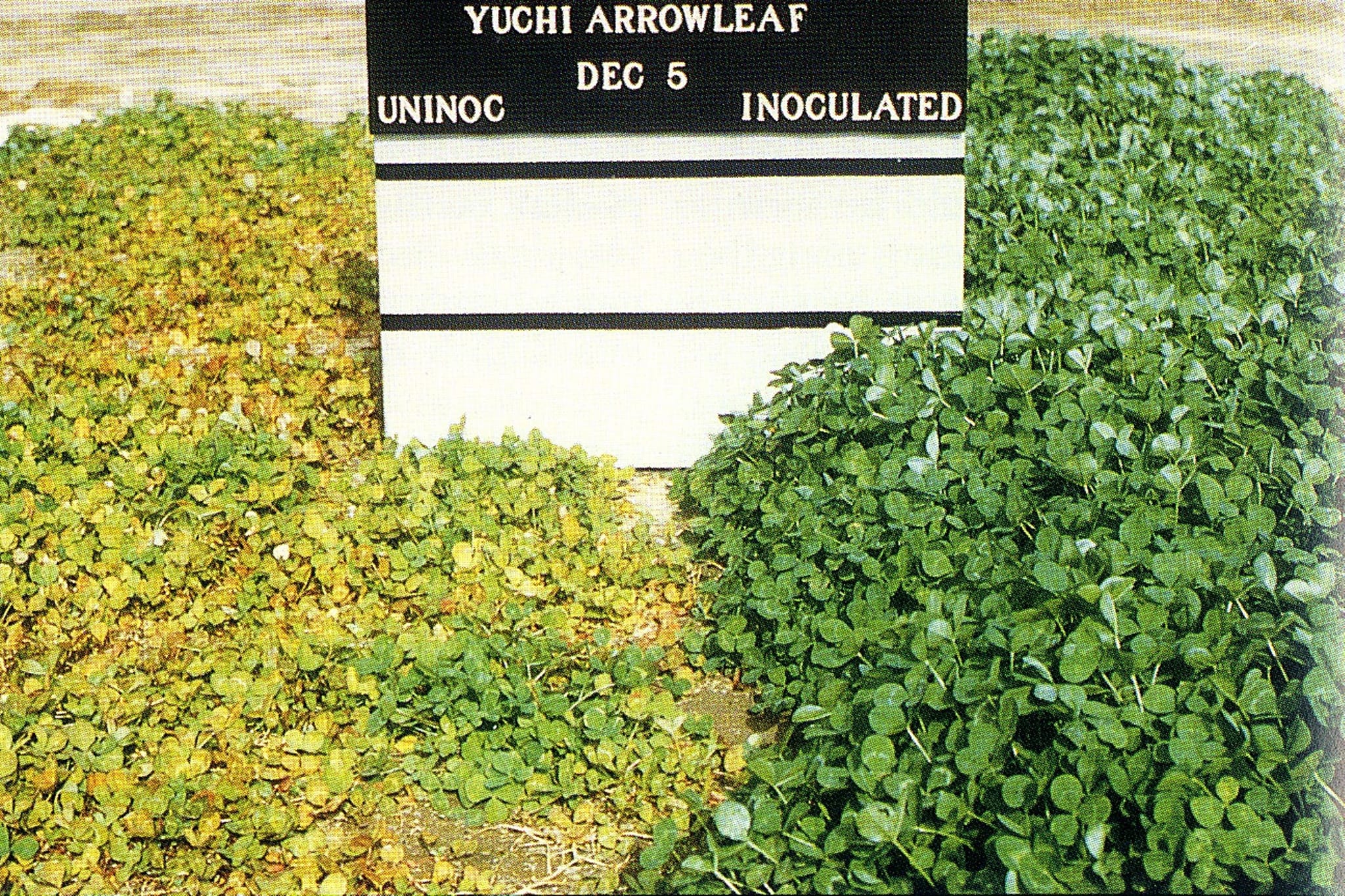
Proper inoculation of legumes will increase forage production and ultimately reduce fertilizer cost by fixing nitrogen in the soil. Therefore, when establishing forage legumes, it is critical that seeds be inoculated with the required rhizobium bacteria (Inoculant Code O for arrowleaf; Inoculant Code R for crimson).
Legume seeds are inoculated by applying live bacteria to the seed with a sticking agent. Sticking agents serve a dual purpose by adhering the inoculant to the seed and by feeding the bacteria until the seed germinates. Although commercial sticking agents are available, a 10% sugar solution or some kind of soft drink works well. Seed should be lightly moistened with the sticking agent prior to applying the inoculant. Apply and mix the inoculant well to insure all seeds are covered . Allow the seed to air dry in order to ensure even distribution from a seeder. However, inoculated seed should be planted within 24 hours to retain viable bacteria.
Several precautions are in order when planting forage legumes. Rhizobium bacteria are very susceptible to heat, and inoculant should be stored in a refrigerator until ready to plant. Inoculated seed should only be planted when soil contains sufficient moisture.
Although the seed might survive if planted on dry soil, most of the bacteria will die before the seed germinates, resulting in poor forage production. Some varieties of clover can be purchased pre-inoculated. Pre-inoculated seeds generally have a lime coating that not only protects the bacteria, but also adheres it to the seed. However, the bacteria will not remain alive for extended periods of time. Fresh seed should be purchased and stored in a cool location until planted.
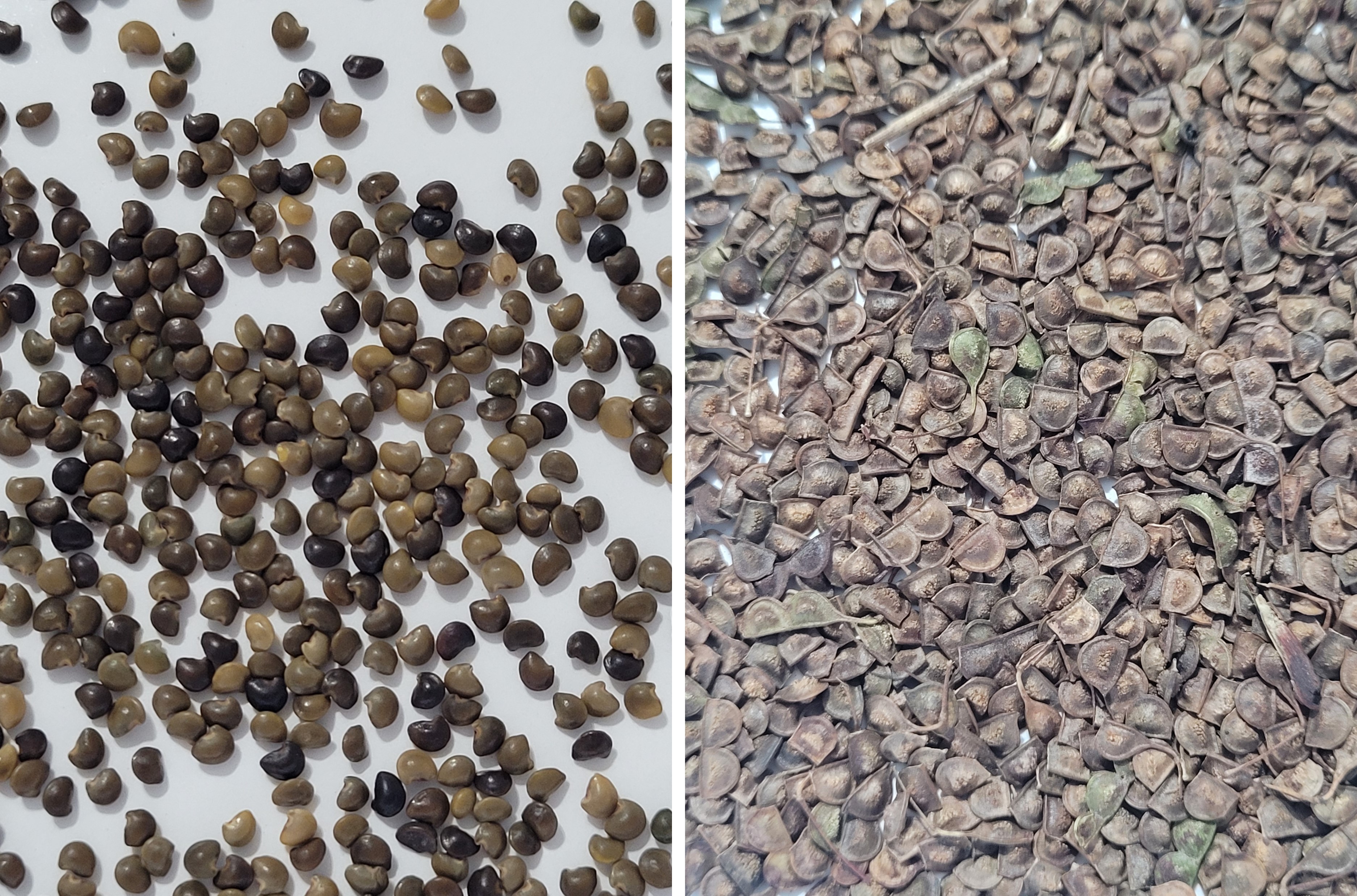
When buying American jointvetch (Deer Vetch) seed you've probably noticed the option to buy hulled vs. unhulled seed.
It's recommend to buy jointvetch seed that has been hulled (hull taken off) and it's been coated with an inoculant.
Both will germinate, but seed with the hull left on takes much lot longer (adapted to be protected from freezing and thawing).
See emergence rates for different seeds in the chart below. The biggest factor for quick seed emergence was whether it still had the hull on it, or not. Followed by if it was inoculated (coated) or not.
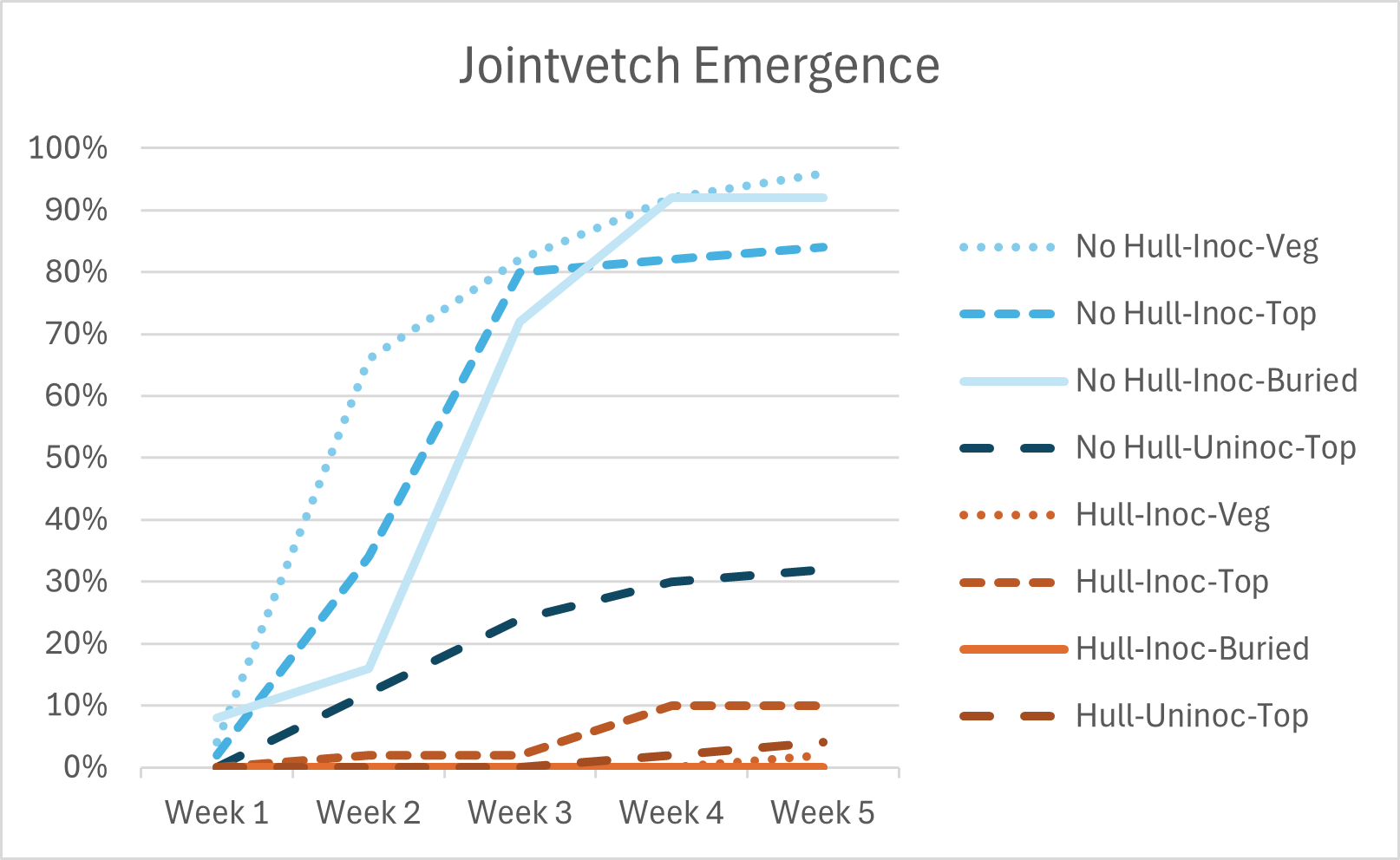
*No Hull - Inoculated - Top Sown with Vegetation Coverage
*No Hull - Inoculated - Top Sown (not covered)
*No Hull - Inoculated - Buried (covered 1-inch with soil)
*No Hull - Uninoculated - Top Sown (not covered)
*Hull on - Inoculated - Top Sown with Vegetation Coverage
*Hull on - Inoculated - Top Sown (not covered)
*Hull on - Inoculated - Buried (covered 1-inch with soil)
*Hull on - Uninoculated - Top Sown (not covered)
An easy and inexpensive method of determining the amount of production and utilization your food plot is getting is through the use of exclosures. They are easily constructed out of suitable fencing material, such as 1x4 or 2x4 wire. Light gauge wire (such as chicken wire) is generally not sturdy enough to withstand adverse weather conditions and contact from foraging deer. The exclosures should be about 3 feet in diameter and 4 feet in height. As a general rule, locate one exclosure for every acre of food plot.
See Exclosure Cages in Food Plots (below)
Have you ever wondered how much forage your food plot is producing, or to what extent wildlife utilize your plot? There is a simple and inexpensive way to get good answers to these questions.
Placing at least one exclosure cage in each of your food plots will demonstrate forage rate of growth and the amount of wildlife usage. An exclosure restricts wildlife access from a small area within the plot, allowing plants to demonstrate how well they grow on each site without the impact of wildlife.
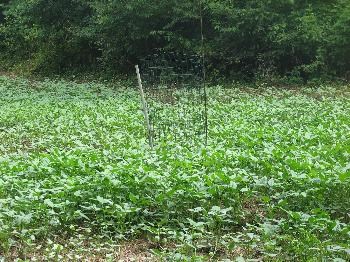 Constructing an exclosure is simple. Cut a piece of wire mesh small enough to prevent rabbits from entering (i.e., 1" x 2") and form a circular or square area at least three feet across and four feet tall. After the plot is planted, stand the exclosure up and secure it with stakes on at least two sides so that it cannot be pushed around by foraging animals, such as deer or feral hogs.
Constructing an exclosure is simple. Cut a piece of wire mesh small enough to prevent rabbits from entering (i.e., 1" x 2") and form a circular or square area at least three feet across and four feet tall. After the plot is planted, stand the exclosure up and secure it with stakes on at least two sides so that it cannot be pushed around by foraging animals, such as deer or feral hogs.
The use of metal stakes such as concrete reinforcement rods (re-bar) is suggested. The exclosure should be placed in a representative area of the plot--avoiding the highest or lowest points, wettest or driest points, or the most or least fertile areas. Placing the exclosure toward the middle of the plot will eliminate competition effects from native vegetation around plot edges, especially trees. Be careful to not place cages where excessive seed or fertilizer was spread or spilled. If you wait until the seed has sprouted and emerged, pick an area representative of the food plot to place the exclosure. Make sure the exclosure is in place as soon as possible after planting to eliminate bias from early use by wildlife.
Records should be kept for future reference as to the growth rate and utilization in plots with exclosures. For each plot, the most basic records of liming, fertilization, soil preparation method, seed rate, and plant species (including variety) should be documented initially. The exact planting date should be recorded, along with any pertinent information about soil or weather conditions.
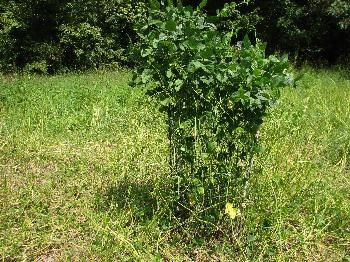 Each plot with an exclosure should be observed periodically, at least once every 2 - 3 weeks, and notes taken at time of observation. These notes should address weather conditions since the last observation, documenting amount of rainfall, temperature extremes, and other weather phenomena. Notes should also be made on food plot use by different wildlife species such as rabbit, turkey, deer, and hogs by track observation, sightings, or fecal droppings.
Each plot with an exclosure should be observed periodically, at least once every 2 - 3 weeks, and notes taken at time of observation. These notes should address weather conditions since the last observation, documenting amount of rainfall, temperature extremes, and other weather phenomena. Notes should also be made on food plot use by different wildlife species such as rabbit, turkey, deer, and hogs by track observation, sightings, or fecal droppings.
At each observation period, the height of the planted species inside and outside the exclosure should be measured. For the height outside the exclosure, take several measurements throughout the plot and use the average. Documentary photographs can also be taken. Take at least one photo of the exclosure with a yard stick or measuring tape placed firmly on the ground and extending upward along the outside of the exclosure. Be sure to include some of the area outside the exclosure and focus the camera so that measurement increments (inches) can be seen on the photo. Take another photo of the entire plot with the exclosure in view. Make sure that both photos are dated and taken from the same location each time.
Evaluating food plot growth and utilization can save time and money and provide more supplemental food for wildlife.
After reviewing the data collected in plots with exclosure cages, you should be able to determine:
With this information, managers can make more informed decisions about food plot management.
There is no distance restriction.
This is so the feed will not sit on the ground in piles. When feed is piled on the ground, there is more opportunity for moisture to come in contact with the feed, which can cause it to mold and sour.
Yes, they do allow feed to come in contact with the ground, but the feed is distributed in a manner so it is not piled. Deer can remove most of the feed the feeder distributes each time it turns on. This will reduce the likelihood that the feed will mold or sour.
This is primarily to reduce conflict between adjoining landowners, lease holders, and hunt clubs.
Once again, this is to reduce conflict between hunters. If feeding were allowed on public land, a hunter who put up a feeder could "claim" that area as their hunting area. Also, it would be extremely difficult to know where all of the feeders were located on public land, which would mean you could be hunting in violation and not know it.